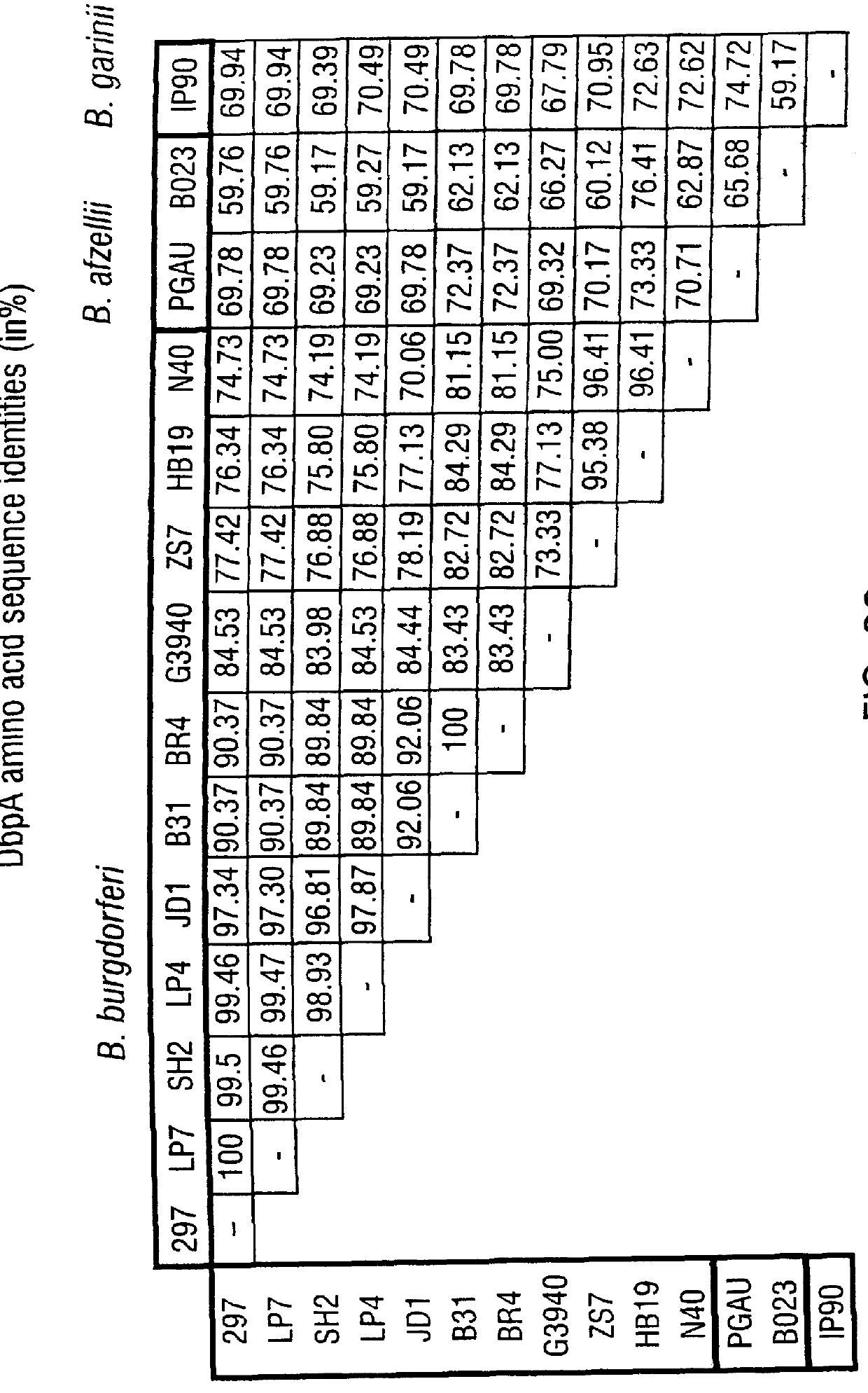DbpA compositions
a technology of compositions and dbpa, applied in the field of molecular biology, can solve the problems of limited site of action of ospa-specific antibodies, human immune responses to ospa subunit vaccines have not matched, and the protection of humans may be difficult to achieve with vaccines, so as to prevent the deleterious effects of this microorganism
- Summary
- Abstract
- Description
- Claims
- Application Information
AI Technical Summary
Benefits of technology
Problems solved by technology
Method used
Image
Examples
example 1
5.1 EXAMPLE 1
Adherence of B. burgdorferi To Dcn
5.1.1 Materials and Methods
5.1.1.1 Bacterial Strains and Culture
Low-passage (fewer than 10 in vitro passages) B. burgdorferi N40 was used for all studies unless specified otherwise. High-passage B. burgdorferi B31 (ATCC 35210) has undergone numerous in vitro passages. B. burgdorferi was cultured in BSKII medium at 34.degree. C. (Barbour, 1984). Cultures were incubated in a GasPak chamber (BBL, Baltimore, Md.) with 3 to 6% O.sub.2 until the cells reached the mid-to late-log phase. Cells were harvested by centrifugation at 14, 500.times.g for 30 min and gently washed in sterile, filtered phosphate-buffered saline (PBS; pH 7.4; 0.137 M NaCl, 3 mM KCl, 4 mM Na.sub.2 HPO.sub.4, 1 mM KH.sub.2 PO.sub.4) three times. The spirochetes were resuspended in PBS, and the cell density was adjusted to 10.sup.9 organisms per ml by use of a reference standard curve relating the A.sub.600 to the organism number as determined by dark-field microscopy. The ...
example 2
5.2 Example 2
Partial Purification of Native B. burgdorferi DbpA and DbpB
DBPs were partially purified by extracting membranes of B. burgdorferi strain N-40. To approximately 1.times.10.sup.9 organisms / ml phosphate-buffered saline (PBS) was added N-octyl-glucopyranoside to a concentration of 1.5%. The mixture was incubated twenty min at room temperature, rotating end over end. The incubated mixture was spun down at 30,000 rpm for 5 min, and the supernatant containing the extracted membrane constituents was removed. The supernatant was dialyzed against PBS overnight at 4.degree. C., changing the buffer once. The dialyzed membrane supernatant was then filtered thorough a 0.2 .mu.m filter and poured through a Dcn affinity column.
The Dcn affinity column was prepared by first purifying Dcn from fetal bovine skin according to the method described by Choi. Purified Dcn was then covalently linked to CNBr-activated Sepharose.RTM. 4B (Pharmacia, Uppsala, SWEDEN), according to the manufacturer's...
example 3
5.3 Example 3
Localization of DBPs to B. burgdorferi Membranes
The adhesive function of DBPs, and their role as targets for growth-inhibitory antibodies, imply that the DBPs are localized to the borrelia outer membrane. To provide additional biochemical support for this B. burgdorferi B3 total membranes were separated into inner and outer membranes (IM, OM) by a recently published isopycnic centrifugation technique (Bledsoe et al., 1994). By detergent phase portioning DbpA appears to be amphiphilic as are OspA and other borrelia membrane lipoproteins (Brandt et al., 1990). To confirm the presence of lipid on these proteins B. burgdorferi B31 was metabolically labeled with .sup.3 H-palmitate (Brandt et al., 1990), lysed, and used in an immunoprecipitation assay with rabbit anti-rDbpA and anti-rOspA. Both DbpA and OspA were found to incorporate .sup.3 H. Thus DbpA is a lipoprotein as predicted by its sequence and membrane fractionation properties.
PUM
| Property | Measurement | Unit |
|---|---|---|
| Inhibition | aaaaa | aaaaa |
| Inhibition | aaaaa | aaaaa |
| Atomic weight | aaaaa | aaaaa |
Abstract
Description
Claims
Application Information
 Login to View More
Login to View More - R&D
- Intellectual Property
- Life Sciences
- Materials
- Tech Scout
- Unparalleled Data Quality
- Higher Quality Content
- 60% Fewer Hallucinations
Browse by: Latest US Patents, China's latest patents, Technical Efficacy Thesaurus, Application Domain, Technology Topic, Popular Technical Reports.
© 2025 PatSnap. All rights reserved.Legal|Privacy policy|Modern Slavery Act Transparency Statement|Sitemap|About US| Contact US: help@patsnap.com



